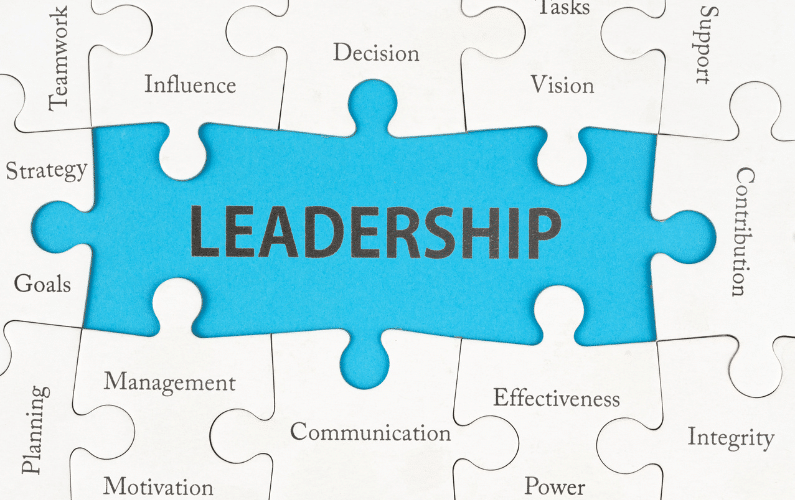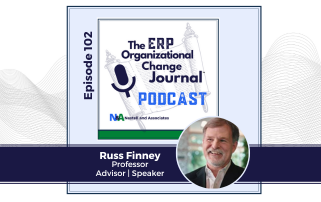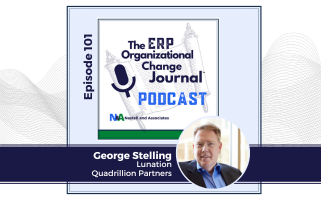ERP leadership is a key factor in determining to what extent ERP organizational change struggles.
Article Contents
- Exploring the Body of Work in ERP Leadership
- The Role of ERP Leadership in Successful Assimilation
- Addressing the Critical Questions in ERP Leadership
- Reflecting on the Value of Leadership in ERP Projects: We All Have Our Flat Spots
- Practical Advice for Enhancing ERP Leadership
- Exploring Theories and Approaches in ERP Leadership
- ERP Leadership: Theory to Practice
Exploring the Body of Work in ERP Leadership
ERP leadership specifically, and leadership in general, is a fascinating topic. Leadership is an interesting topic about which many have spent a great deal of time studying, researching, lecturing, and writing. Many practitioners and researchers have put a great deal of emphasis on understanding “good” leadership. A simple search on the internet will demonstrate that a large array of ideas, opinions, thought, research, and theory exist.
- Some share that leadership is a complex idea. Others share that leadership can be boiled down into a couple of simple principles.
- some have studied the history of leadership and shared how leadership ideas have varied over the centuries and then try to understand why. Those that have studied leadership historically have described evolution as well as contradictions in approaches and thought. Even contemporary leadership scholars have various contradicting ideas on leadership.
One common theme that research does suggest, is that it may be possible, quite possible, that ERP leadership is the key factor that determines to what extent ERP organizational change struggles. Leadership may be a primary reason, if not the number one reason, that ERP specifically and organizational change generally fails or succeeds.
The Role of ERP Leadership in Successful Assimilation
Most would agree that there are three truisms of business and life; people know what they know, people know what they don’t know, and people don’t know what they don’t know. Often upon the commencement of an ERP organizational change endeavor, the organization has no experience or understanding of what lies ahead nor what is needed to accomplish such a resource-intensive task.
Significant diversity factors exist within an organization’s culture including value, functional, motivational, knowledge, and technical to name a few. Additionally, often various stakeholder groups have different ideas of success and understanding of what is required for a successful project. And then, you combine that with all of the individual personalities and characters with significant degrees of conceptual and functional understanding, interest, ownership and commitment levels, learning styles, learning curves, and transitional tolerance. Each employee is different, human cognition is limited as each team member differs in opinions, values, and ways of thinking.
There is a great deal of flux in the context of ERP organizational change and employees handle this flux in different ways. Neumann (1993) reminds readers that the human psyche is attuned more to stability than to flux. Employees, especially in highly desperate times in which the future of a business is unknown are more comfortable and at ease when expectations, direction, and plans are known and effectively communicated. Perhaps the key to successful ERP organizational change depends on the soft-skills and more abstract characteristics of an organization with a strong focus on the “human factor”. A leader can not just lead assuming everyone understands this point. ERP organizational change can be quite disruptive. The key is in large part effective leadership: education of the organization and presenting the honest realities and expectations to overcome these diversities and general organizational learning curve.
Addressing the Critical Questions in ERP Leadership
There are great ERP leadership questions that deserve reflection. Are there leadership common denominators and patterns? Are there different types of leadership styles for those organizations that have realized ERP success versus those that struggle?
One thing that can be agreed upon is that there is good and bad leadership. We have all to some extent or another personally observed this fact. But why? Is leadership so simple that it can be boiled down to a couple of principles? If so, does that mean that effective leadership is an easy idea to grasp but significantly challenging tactically to execute? After all, boiling leadership down to a couple of simple principles is one thing but understanding how and why those principles are effectively translated into effective leadership in the workplace is another story. The proof is in the pudding.
On the other hand, if leadership is truly a mix of many complex social, psychological, behavior, conditional, etc. factors, then how do we possibly determine common denominators in which we determine a “good” leader? Or, how do you as a leader begin the process of being a better leader? Is there a leadership style that is most effective for an ERP organizational change effort?

There are great ERP leadership questions that deserve reflection.
Reflecting on the Value of Leadership in ERP Projects: We All Have Our Flat Spots
“Education is not preparation for life; education is life itself.” – Dr. John Dewey
It is one thing to be told, or suggested, what “theories”, “factors”, “attributes”, “approaches”, and “principles” determine a good leader, it may be entirely different to put these factors into action in the workplace. But, perhaps, to be a good or better leader, it all simply starts with self-reflection? Sometimes organizational leaders can be quite focused on operations, transactional activities, and meeting key performance indicators (KPIs), that time for consideration and reflection is put on the backburner. Studying leadership, or at least reflection in leadership, can not only help one to continue to develop as a person but as leader.
Leadership reflection requires thinking outside the box and allowing yourself to be put in productive but uncomfortable positions and learning experiences. Genuine reflection of leadership allows one to continue to challenge one’s own mindset, views, opinions, and perspectives. Personal leadership development allows one to continue to bring value to a company and those around you through professional development, being a positive contribution to corporate culture, and exemplify leadership even, and especially, in difficult situations.
Afterall, a leader’s ambition ought to be to continue to understand before being understood. The different lenses of leadership are useful to understand so that they can be used as a productive, meaningful, practical, and genuine tools. Therefore, the desire for this article is to simply articulate some ideas that the reader may find helpful for consideration and reflection.
Practical Advice for Enhancing ERP Leadership
A great deal of “advice” exists for being a good leader. There is no shortage of leadership literature that shares or suggest the best leadership “factors”. If you search the internet for “factors that determine good leadership” for example, you will see lists such as “Top 10 factors…”, “Four Key Factors..”, “Top 2 factors…” and “20 most important factors…”, and on and on. And, all of these articles may be true. Whether through personal experience, anecdotal evidence of others, research, or observation, articles suggest leadership attributes, skills, approaches, or traits such as; “be inspirational”, “patience”, “courage”, “focus on finding solutions”, “good communication skills”, “control your emotions”, “be empathetic”, “trust your instinct”, “have a shared vision”, “problem solving ability”, “lead from the front”, “lead from the back”, “take responsibility”, “personality”, “build trust”, “can motivate”, “attitude”, “have passion”, “faith”, “transparency” and many, many more. Who could possibly disagree with such attributes, skills, approaches, and traits?
Additionally, which of these “factors” may be heavily influenced by a leader’s intelligence quotient (IQ)? Which of these are heavily influenced by emotional quotient (EQ)? And what about adverse quotient (AQ), spiritual quotient (SQ), creative quotient (CQ), or even the why quotient (YQ)? Surely, these quotients impact “good” leadership? Do “good” leaders simply have a high IQ and a high EQ? Is simply the IQ and EG duet the key to successful leadership? And, what if effective leadership may vary in different organizational contexts? Couldn’t good leadership be a combination of a trait, a behavior, a matter of skills, a matter of process, contextual, relational, or most influenced by political wherewithal and power relationships?
Exploring Theories and Approaches in ERP Leadership
“Collectively the research findings on leadership provide a picture of a process that is far more sophisticated and complex than the often-simplistic view presented in some of the popular books on leadership” (Northouse, 2022)
No doubt about it, there is a vast amount of research, literature, thoughts, and opinions on leadership theory. But, for many organizational leaders, leadership development comes not necessarily from the study and research of leadership theories but are based on observation as well as personal experience in the workplace. Most leaders would likely acknowledge that they have had no formal training on this topic. For many organizational leaders, anecdotal experience or evidence and observation has guided their leadership thought and practice.
Most organizational leadership has a true passion and desire to bring the greatest value possible to those organizations that entrust their leadership. Self-assessments, reading, and reflection help set the tone for understanding the varying perspectives, and mindsets, for viewing not only leadership but also for the context and process of being a “good” leader. Reflection upon anecdotal evidence and one’s personal experience is priceless. Additionally, understanding leadership theory and what evidence-based practice and research teaches us as leaders is priceless as well. Perhaps leadership is a trait and a process and dependent upon the context as well as previously mentioned. The context of leadership including globalization and generational differences (Kezar, 2000; Angeline, 2011) is dynamic. Some in academia have considered leadership as a trait or behavior, and others considered leadership as more of an information processing, relational, and contextual standpoint (Northouse, 2016). Furthermore, effective leadership benefits from the examination of the business context from various lens or frames as well (i.e. a structural, HR, political, or symbolic. See Deal & Bolman, 2013).
“Leadership research is increasing dramatically, and findings underscore that there is a wide variety of different theoretical approaches to explain the complexities of the leadership process.” (Northouse, 2022).
There have been volumes written on the below ideas, but as a matter of illustration, here are some examples of leadership theory and ideas. Please refer to references below for more information. Here are some theories and approaches that just scratches the surface but is “food for thought” none-the-less; Trait Approach, Skills Approach, Behavioral Approach, Situational Approach, Path-Goal Theory, Leader-Member Exchange Theory, transformational leadership, authentic leadership, servant leadership, adaptive leadership, and Inclusive leadership (Northouse, 2022). Let’s take a quick look at some of these below.
The “Trait Approach”, this is more your “nature”, your disposition, the “way you are wired”. But even with a given disposition, the traits a leader possess must be relevant to a given context (Northouse, 2016). Natural tendencies and traits have significant impact in one’s leadership approach. Self-confidence, determination, integrity, persistence, and conscientious would be other strong traits.
The “Skills Approach” explains that given that traits are considered to be fairly innate as a leader, we also put a great deal of emphasize on the “skills” of leadership. Social intelligence, social perceptiveness, and behavior flexibility are strengths that can be learned and developed over time.
The “Behavioral Approach” to leadership focuses on task behaviors and relationship behaviors. This model describes the major components of behavior versus telling leaders how to manage.
“Situational Approach”, leadership depends on context and situation. Sometimes the best leadership style may be learned out of necessity based on one’s career work or context. In addition, based on the business environment, leadership depends on who and when you need to send a message. There is a thousand different ways to package and send the exact same message. That is, all of us may have a natural disposition and character to be a certain type of leader, as well as follower, based on nature and nature.
The idea with Path-Goal Theory is to improve team performance by focusing on team motivation. Essentially focus on the leader’s style relative to characteristics of followers and the organizational context. That is, adjust leadership to meet follower’s motivational needs and leaders provide followers with what is needed so that followers can reach their goals. Leaders strive to provide involvement and build team and organizational cohesiveness. Team members in these cases are often in need of some control, clarity, and vision. The primary emphasize of this theory is supported by Wheeler (1998) who states that a primary and basic principle of leaders is the inclusion of employees as stakeholder, alignment of values, and commitment to share perspectives and beliefs with effective communication. Approaching leadership from the perspective of this theory is important because it would help followers curb concerns, worries, and anxieties (Northouse, 2022).
Intuitively understanding leadership as requiring certain traits and skills and in context seemed from the surface fairly practical. “Leader-Member Exchange Theory”, LMX, however, is understanding leadership as a process based on individual interactions. The notion of an “average leadership” style across a team in a collective and consistent way appears to be common in most literature. Depending on the follower, the interaction, the message, the delivery of the message, and the style of the message can vary in order to cater the individual’s character. It is interesting how Northouse (2016) points out that Graen and Uhl-Bien (1991) advocate that leaders will be most effective if a special relationship is created with all followers. Interesting point in that leadership mind-set, perspective, and approach should and could vary on a more granular individual basis within an organizational team. This model is interesting in that it is really suggesting that leadership needs to be studied at a more granular per person approach.
Transformational Leadership is a focus of being very cognizant of human relationships, emotions, and thoughts. This as opposed to functional, systems, concrete transactions, technical project tasks that tend to be more tangible, testable, and task oriented. And, then tend to be easier to quantify and measure. Transformation leaders need to have an intuitive and practical appeal. That is, it is an approach where the leaders need to be taking the lead in advocating change. It simply makes sense and is appealing to followers that leadership has a vison of the future and can effectively articulate, support, and envision the improved future. The transformational leader has tolerance for, and can guide, challenges through change. Because transformational leadership is a process between leader sand followers, transformational leaders have to address the needs of the followers (Northouse, 2022). ERP organizational change is an extremely trying time for many employees. Transformational leadership “includes motivating followers to transcend their own self-interests for the good of the team, organization, or community” (Northouse, 2016, p. 177). The fact is that even with the perfectly laid out project plan there are just too many unknowns. Transformational leaders are able to effectively navigate the organization through the uncharted territory.
Theory to Practice
Research would suggest and agree with Northouse (2022, p. xv) whom shares that that there is some work to do in “bridging the gap between the often-simplistic popular approaches to leadership and the more abstract theoretical approaches.”
Even if, or when, leadership attributes, skills, approaches, traits, or quotients are understood, this is in part where “rubber hits the road”. Being cognizant of these ideas as well as leadership theory is invaluable, but then tactically being able to execute in practice is equally invaluable. Leadership depends on being armed with the tools to be effective. Perhaps leadership attributes, skills, approaches, traits, and quotients are one thing, but leader “lens”, context, worldviews, also matter? Leadership can be complex and there are many variables in terms of leadership styles, traits, attributes, mindsets, and context. Formal and academic research has provided a great deal of insight into these ideas. Additionally, Schein (2004) shares that leaders need to implement and utilize procedures and systems that act as reinforcement mechanisms to emphasize and support that fact that historically evolved inconsistencies in the past organization culture are being addressed. (Side note: Leaderships ability to promote an organizational culture that advocates and endorses change has a significant impact on ERP organizational change success.)
Improving one’s leadership skills means, in large part, being cognizant of leadership theory and then reflecting and implementing in practice. Leadership based on theory is one thing. But to actually have, and effectively utilize the leadership knowledge takes intentional and deliberate practice, meditation, experience, and many times trial and error which can often come from years of “school of hard knocks” or “on-the-job training”. It is relatively easy to “talk theory” but the practice of effective leadership, maybe not always so easy to do. Practitioner consultants, leaders, and researchers may sometimes have differing ideas and approaches to leadership. But perhaps, starting with intentional self-introspection is the first step towards bridging the gap between the often-simplistic popular approaches to leadership and the more abstract theoretical approaches. In other words, one’s own contemplation and reflection of personal leadership experience and observation combined with knowledge of the leadership body of work are compliments for each other and the place to start.
You may have heard leaders dismiss solid objective research over experience. But, the overall goal of leadership whether in theory or practice is to “advance our understanding of the many different approaches to leadership and ways to practice it more effectively” (Northouse, 2016, p. xviii). Throughout one’s career, intentionally adjusting leadership practice based on; 1) following examples of those mentors that one would deem as successful, and 2) based on the context of the leadership, 3) self-reflection, and 4) better understanding of leadership theory are all valuable leadership development tools. The evolution of academic leadership theory and studies since early 1900 through today demonstrates the dynamic world of leadership thought. And, the changing world and hence the changing context of leadership contributes to this dynamic nature of leadership thought. The 21st century continues to see a great deal in leadership study and theory:
“We are at a crossroads where we need to profoundly challenge the way we approach leadership, and we need to learn to think about leadership in new ways” (Kezar, 2000, p. 7).
This article barely scratches the surface but was intended as a matter of illustration. Despite what one may have learned, know, and understand about the value of leadership, we certainly call all recognize and reflect upon flaws and gaps as a leader. As leaders, we should be compelled to cultivate and provide a concrete plan that advocates for the development of leadership skills and guiding throw difficult situations. We may all benefit from deliberately removing ourselves from our own shoes more often and consider looking at issues from various, and sometimes totally different, perspectives.
There are no doubts, many different leadership lenses, mindsets, approaches that exist. Therefore, it is helpful for leaders to consider and articulate their specific leadership definition and theory that they align with as well as their lens in which they approach leadership. This can happen by simply and intentionally exploring the attributes of one’s own leadership style and then reflecting. Good leaders do in fact take deliberate time not to “stew over” issues and challenges but to reflect on situations from different lenses.
The strategy of organizational leaders is usually a default position taken based on anecdotal experience and perhaps may not consider leadership theory, science, research, collaborative learning, and case studies. That is, leaders may perhaps rely heavily on anecdotal experience that assume that teams can come together in a cohesive manner in order to accomplish the task at hand in order to generate the desired organizational outcome, and that this can only be done one way. But, perhaps, there is a leadership style than can deliver the same positive results but even more effectively and efficiently? So perhaps, one vison or idea of effective leadership is one in which a leader is able to develop and utilize skills, traits, and different leadership methodologies in a combination of ways that are most effective in the context of the organization, culture, problem and challenges. Perhaps reflecting on subjective experience as well as objective research as to what effective and effective leadership may look like is the leadership secret sauce? In part, we do know what makes a good leader; continuing to leverage strengths but yet build upon weaknesses and practice leadership mindfulness.
Seems to me that perhaps great leaders know when to pull the other tools out of their tool box in terms of being a situational leader or a transformational leader or an authentic leader or a servant leader or an adaptive leader, etc. Even though their disposition tends to have them feature one over the others. Northouse (2016) states that it is important for leaders to understand where followers are on the “development continuum”. The leader then needs to adjust leadership styles to directly match the follower’s development level.
……food for thought.
“Knowing yourself is the beginning of all wisdom.” — Aristotle
Author
Dr. Jack G. Nestell
Article References
- Deal, T.E., & Bolman, L.G. (2013). Reframing Organizations (Fifth ed.). San Francisco: Jossey-Bass., https://www.amazon.com/Reframing-Organizations-Artistry-Choice-Leadership/dp/1118573331
- Northouse, P. G. (2022). Leadership Theory and Practice (Ninth ed.): Sage., https://us.sagepub.com/en-us/nam/leadership/book27013
- Kezar, A. (2000). Pluralistic leadership Bringing diverse voices to the table., https://journals.sagepub.com/doi/abs/10.1177/108648220000500304
- Angeline, T. (2011). Managing generational diversity at the workplace. doi:10.5897/AJBM10.335, https://academicjournals.org/journal/AJBM/article-full-text-pdf/2CD4D3B15906
- Wheeler, D. & Sillanpaa, M. (1998). Including the Stakeholders The Business Case., https://www.sciencedirect.com/science/article/abs/pii/S0024630198000041
- Schein, E. H. (2004). How leaders embed and transmit culture.,
- Graen, G. B., & Uhl-Bien, M. (1991). The transformation of professionals into self-managing and partially self-designing contributors: Toward a theory of leadership-making. https://digitalcommons.unl.edu/managementfacpub/16/
Explore the Transformative Power of ERP Leadership with Nestell & Associates
You Might Like these Related Articles
Private Equity ERP Success: Trust Is A General and Significant Theme
ERP Culture: Transforming Organizational Change into Triumph
Related Podcast Episodes – ERP Leadership
Episode 96: Transforming Organizational Culture with ERP Leadership Training and Virtual Meetings
Episode 92: Answer Intelligence: Elevating Business Communication & Leadership
Episode 82: Practical ERP Leadership with Effective Leadership Strategies
Latest Podcast Episodes – “The ERP Organizational Change Journal”
Human Capital in PE-Backed Companies: Strategies for Leadership and Talent Management
Human Capital in PE-Backed Companies: Strategies for Leadership and Talent ManagementEpisode Overview - PE-backed Human Capital Strategies Today’s episode centers on the pivotal role of human capital in PE-backed companies, emphasizing how strategic leadership and...
ERP Organizational Change: Technology Strategy
ERP Organizational Change: Technology Strategy and Keys to SuccessEpisode Overview - Technology Strategy In general, at the highest level of categorization, there seems to be consensus on the importance of people and culture, informational technology, and project...
AI and Private Equity Synergy: Fueling Business Transformation
AI and Private Equity Synergy: Fueling Business TransformationEpisode Overview - AI in PE Strategies In this episode, we explore how AI and Private Equity synergies are fueling business transformations and reshaping investment strategies and operational efficiencies....




